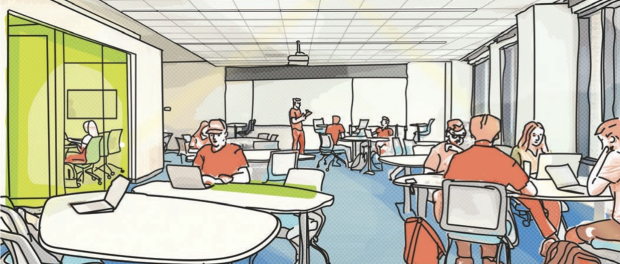New Research Highlights How Inclusive Campus Design Strengthens Student Belonging and Success
 Graphic from Ayers Saint Gross’s 2025 “Comparing Campuses: Spaces for Belonging” Research. Courtesy Ayers Saint Gross.
Graphic from Ayers Saint Gross’s 2025 “Comparing Campuses: Spaces for Belonging” Research. Courtesy Ayers Saint Gross.
Award-winning interdisciplinary design firm Ayers Saint Gross has released its annual Comparing Campuses research, this year titled Spaces for Belonging. The 2025 edition explores how evidence-based campus planning and design strategies can promote authentic student connections, a crucial factor in academic, social, and emotional well-being.
Now in its 27th year, Ayers Saint Gross’s Comparing Campuses series blends visual data with real-world case studies to examine the ways colleges and universities find success in reflecting institutional values through design. The 2025 research builds on this legacy, outlining 12 actionable strategies that promote inclusion, engagement, and institutional resilience through the built environment.
These include:
- Adjustable thermal comfort solutions
- Furniture variety, flexibility, and mobility
- Unobstructed circulation
- Adjustable or layered lighting solutions
- Transparency and visibility
- Accessible power and technology
- Adjustable or layered acoustic solutions
- Zones for connection and retreat
- Daylight access and outdoor views
- Physical, cognitive, and cultural inclusion
- Adaptability and customization
- Biophilic patterns and materials
“Belonging is a universal human need, and on campus, it can mean the difference between flourishing or falling through the cracks,” explains Shannon Dowling, Principal at Ayers Saint Gross. “Our research shows that inclusive, welcoming spaces do not happen by accident. They are the result of planners, architects, and university leaders making intentional, human-centered design choices that reduce barriers and strengthen community.”
Drawing on national survey data and Ayers Saint Gross’s experience across a diverse portfolio of higher educational work, the research is grounded in real-world examples, including those from the firm’s projects at the University of North Texas at Frisco, Ringling College of Art and Design, University of Maryland, University of Arizona, University of California, Berkeley, Delaware State University, University of Baltimore, and Bowling Green State University.
By centering the needs of today’s student population, which is increasingly diverse in terms of age, identity, and life circumstances, the research offers planners and institutional leaders a practical toolkit for translating inclusive values into physical campus design. The strategies outlined help to create campus spaces where students can see themselves reflected, feel valued, and feel free to engage or recharge. When integrated holistically, these elements reinforce a strong sense of belonging and inclusion across the entire academic environment.
“These strategies may be subtle in execution, but their impact is far-reaching,” says Laura Wheaton, Senior Associate at Ayers Saint Gross. “They create spaces where all students feel seen, supported, and empowered to succeed.”
Comparing Campuses: Spaces for Belonging was formally presented last week at the 2025 Society for College and University Planning (SCUP) Annual Conference. With this latest research, Ayers Saint Gross builds on its legacy of leadership in higher education design, aiding institutions nationwide in translating their values into physical spaces that empower students to thrive.
